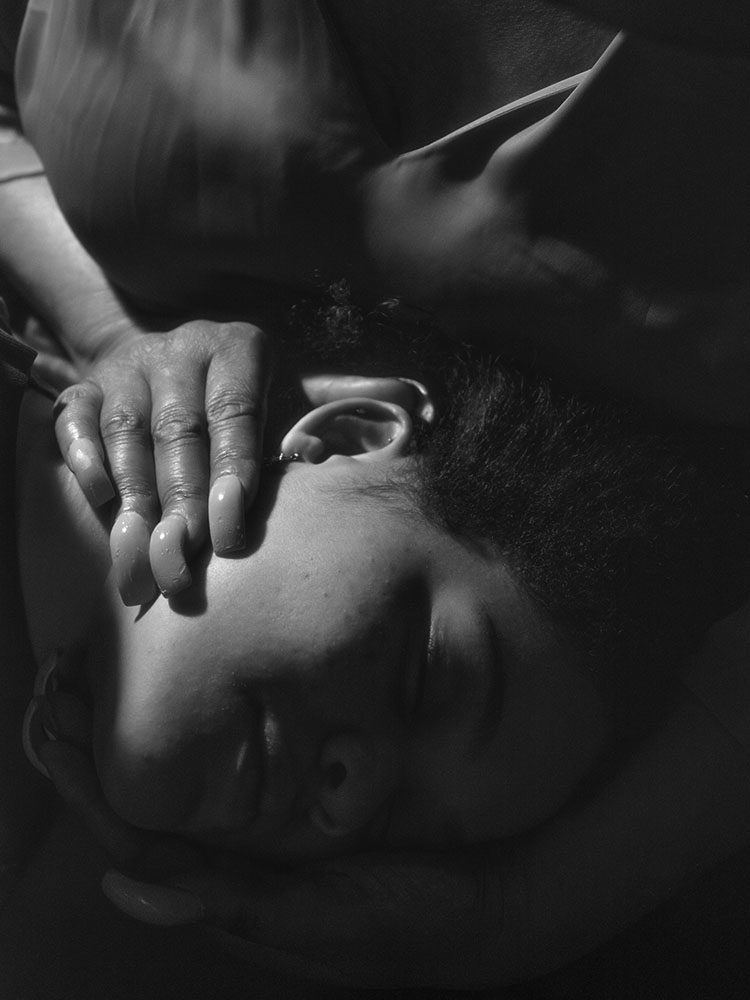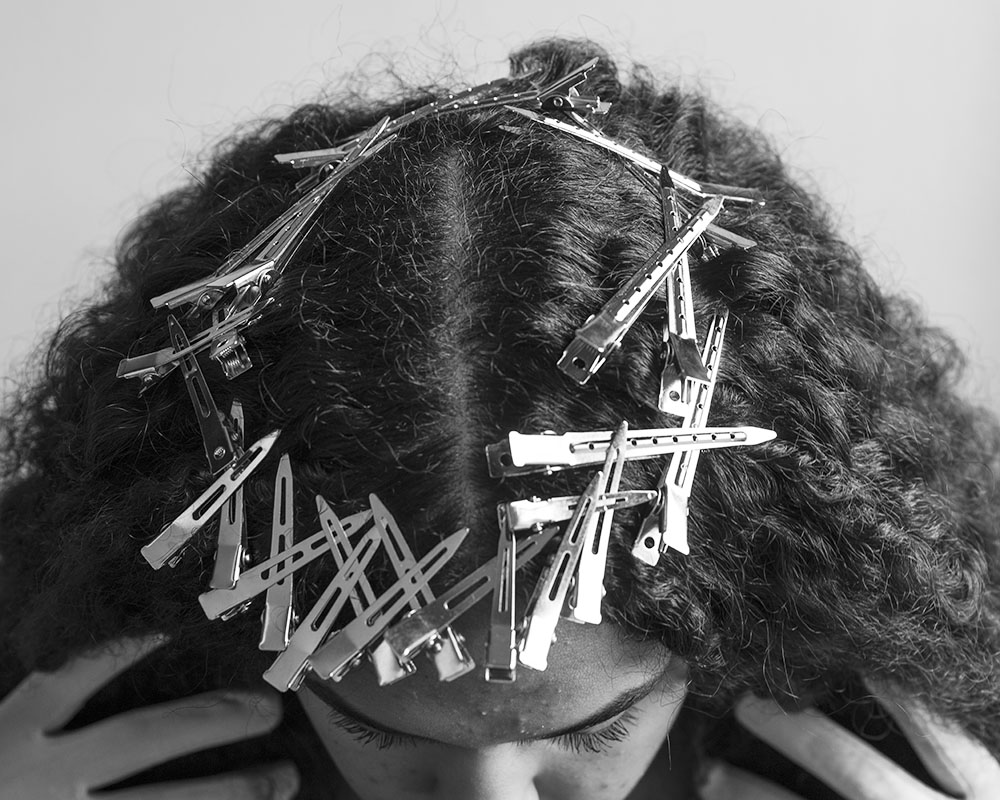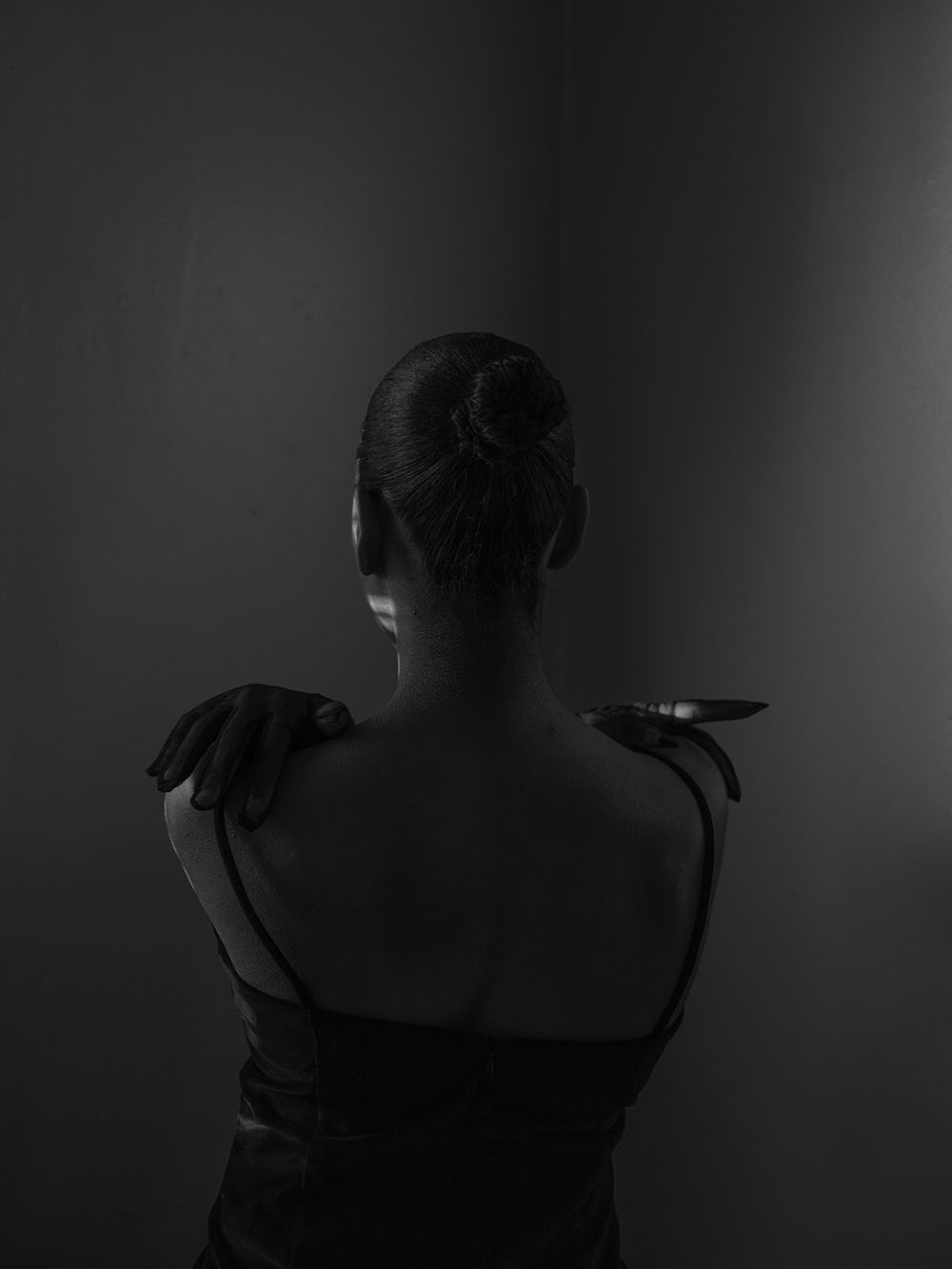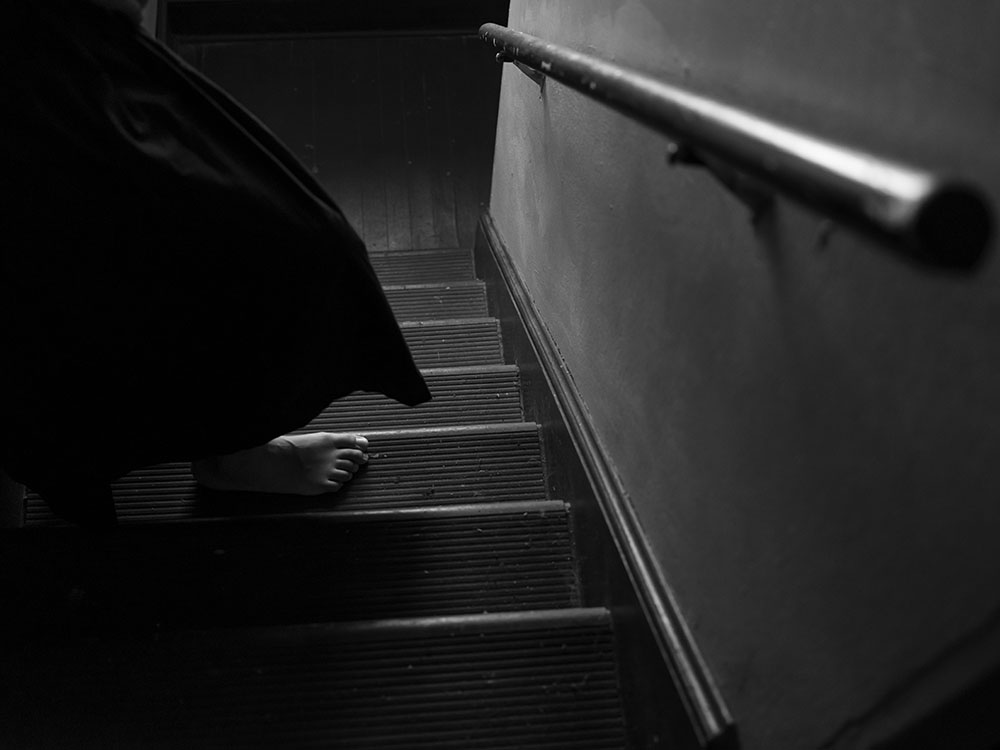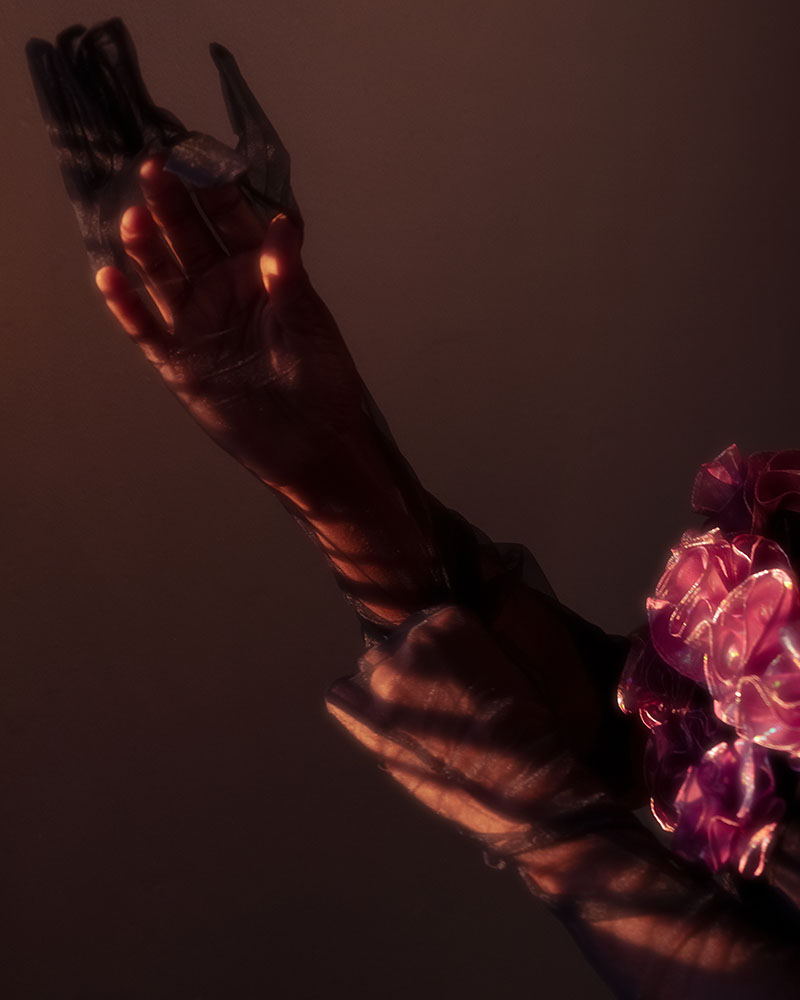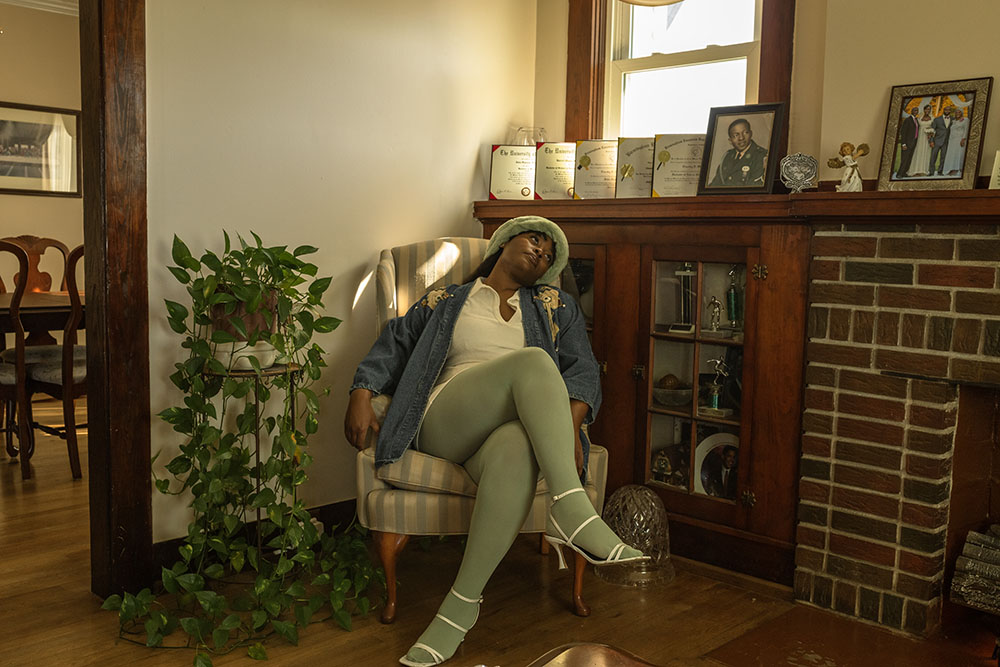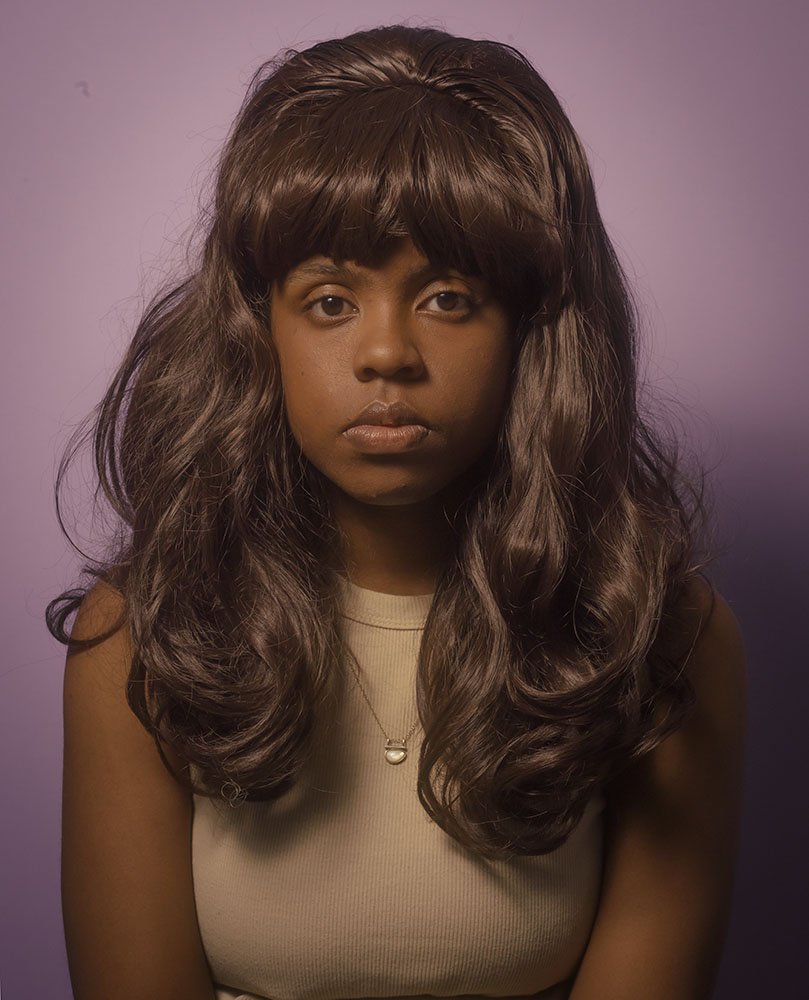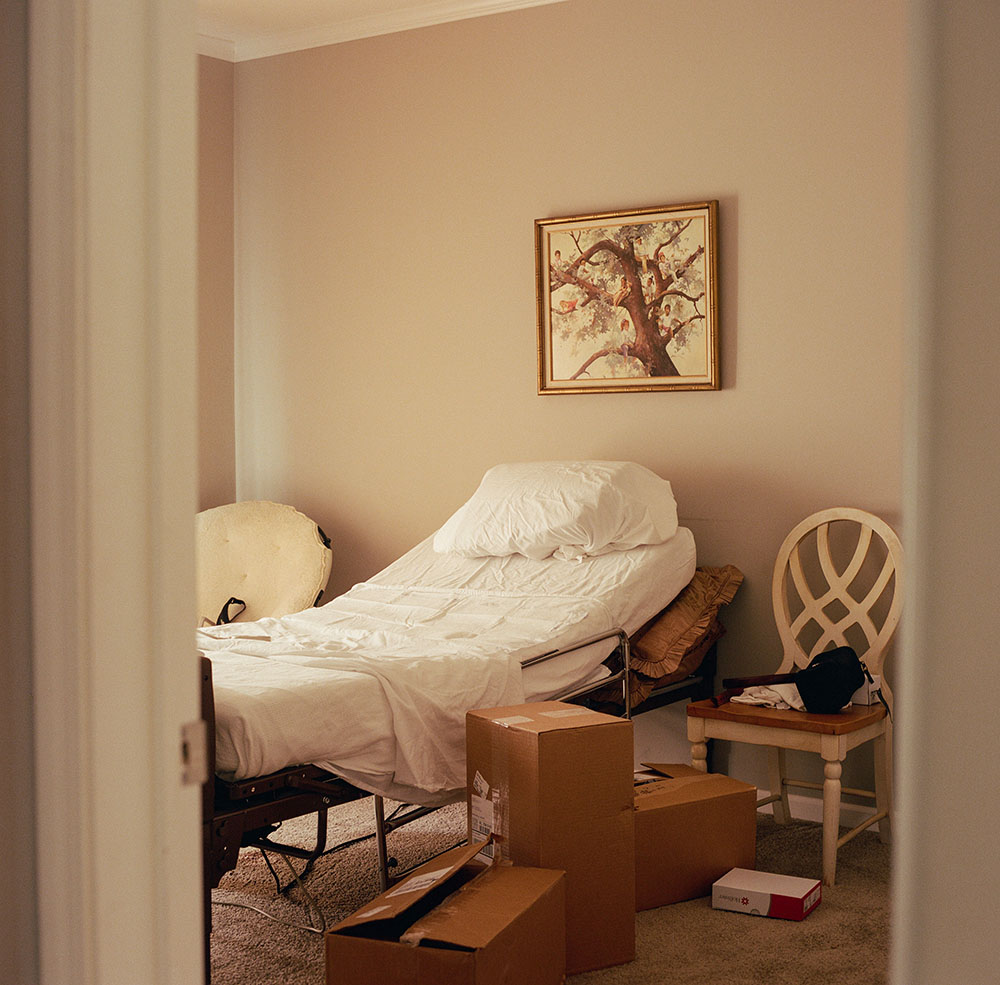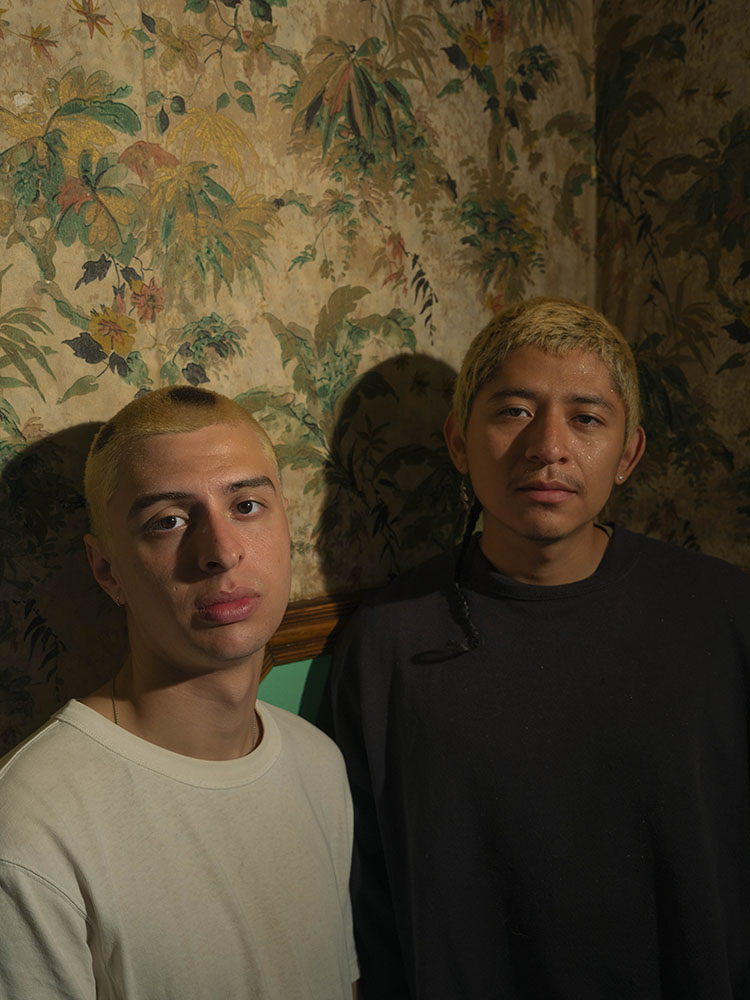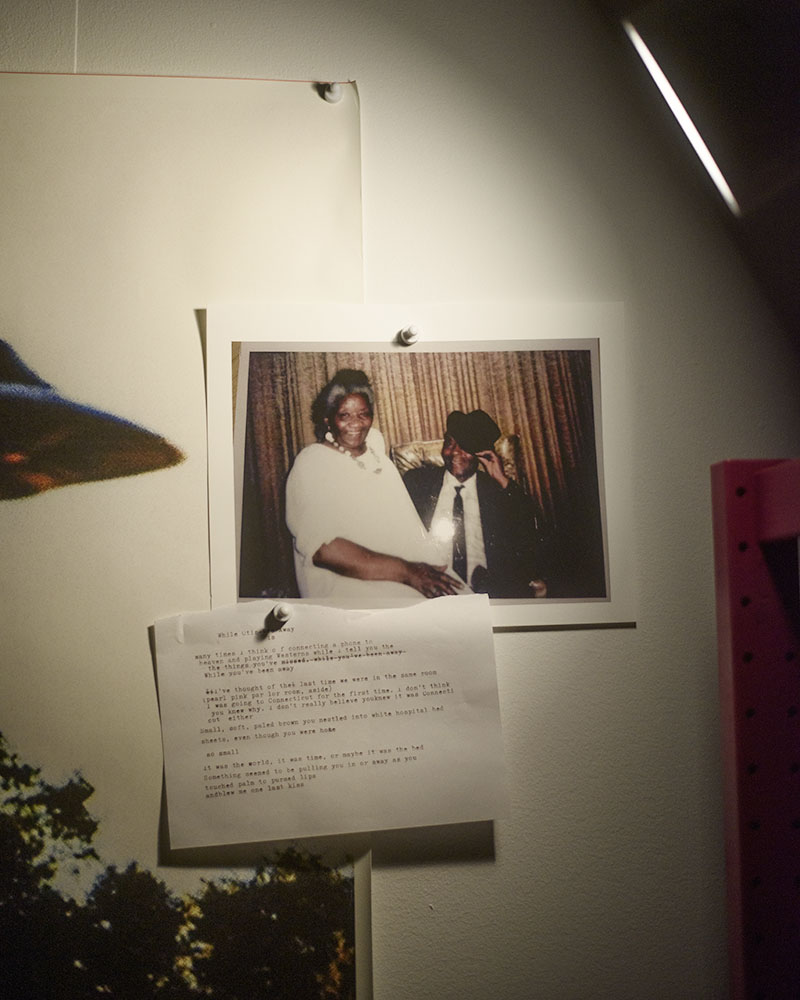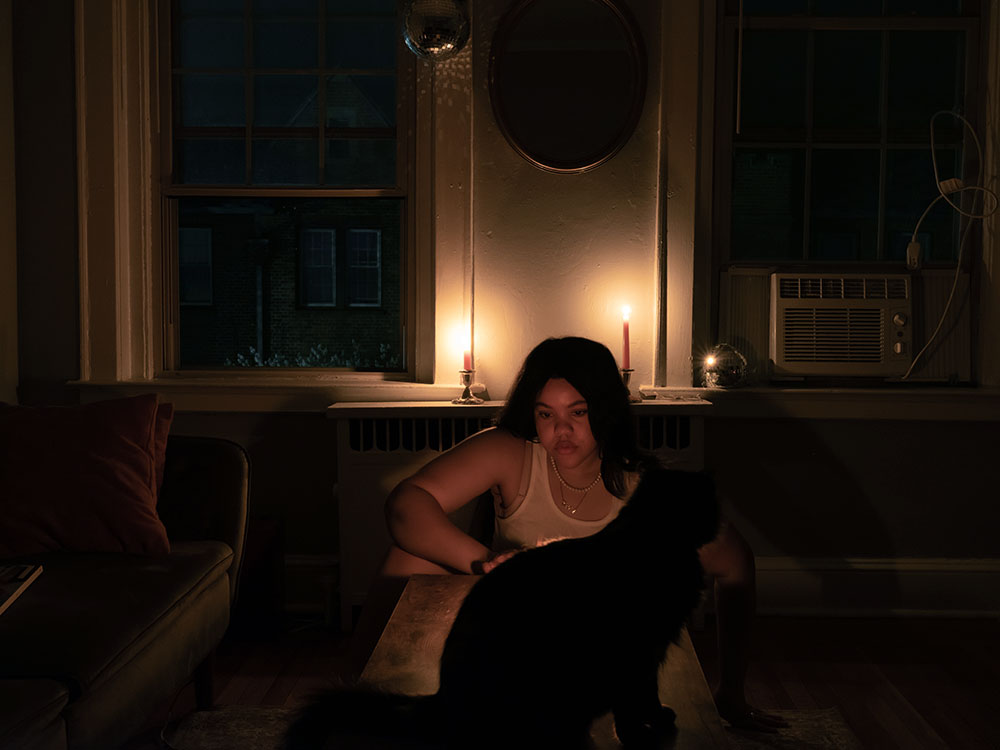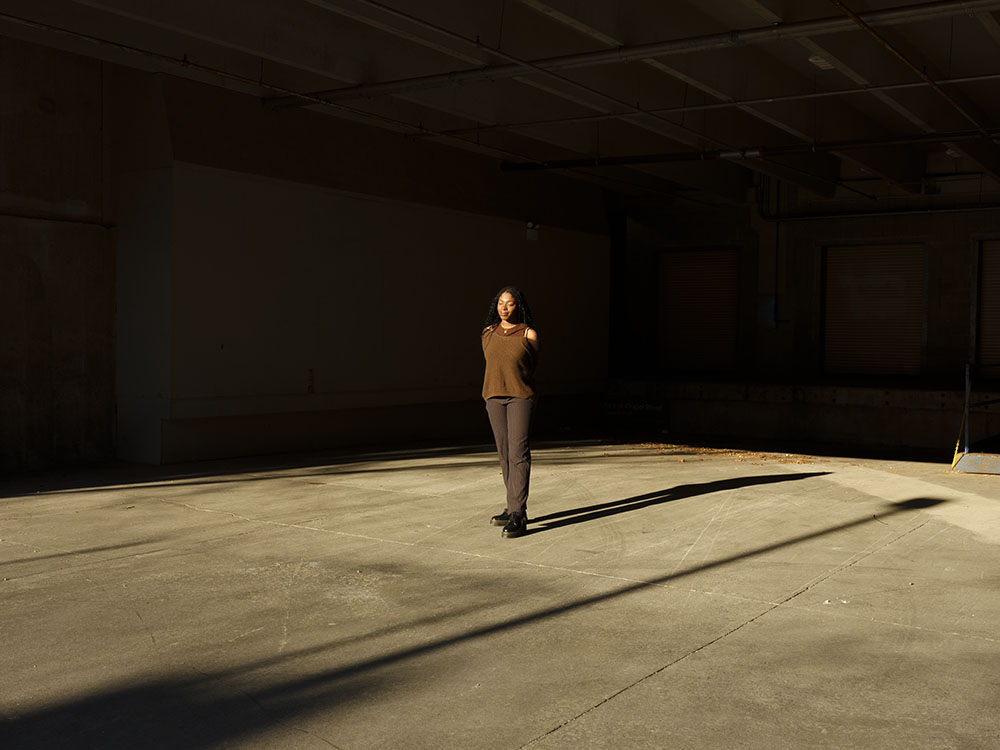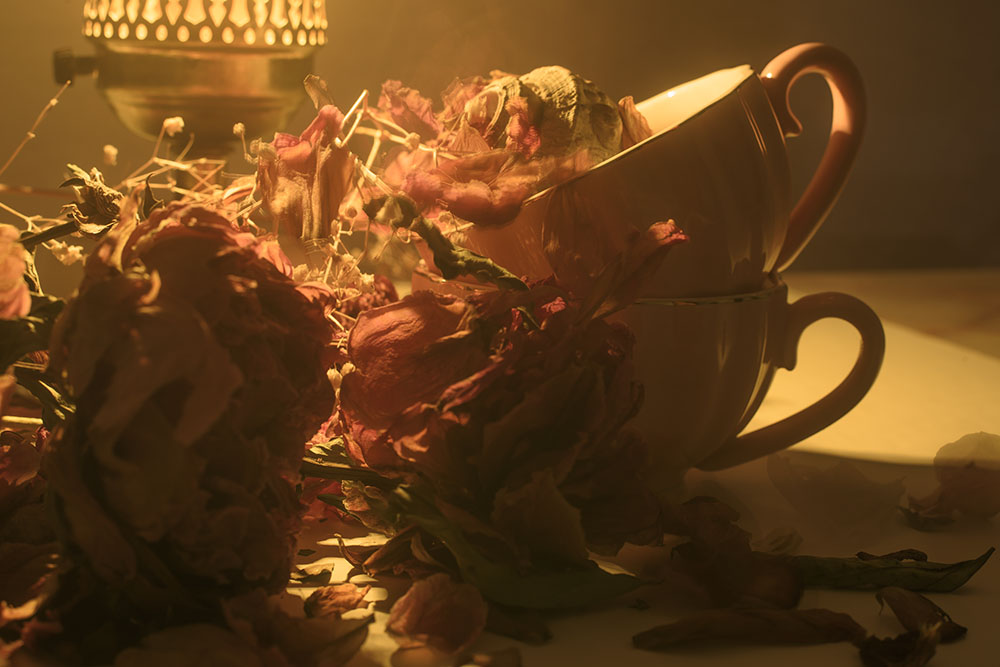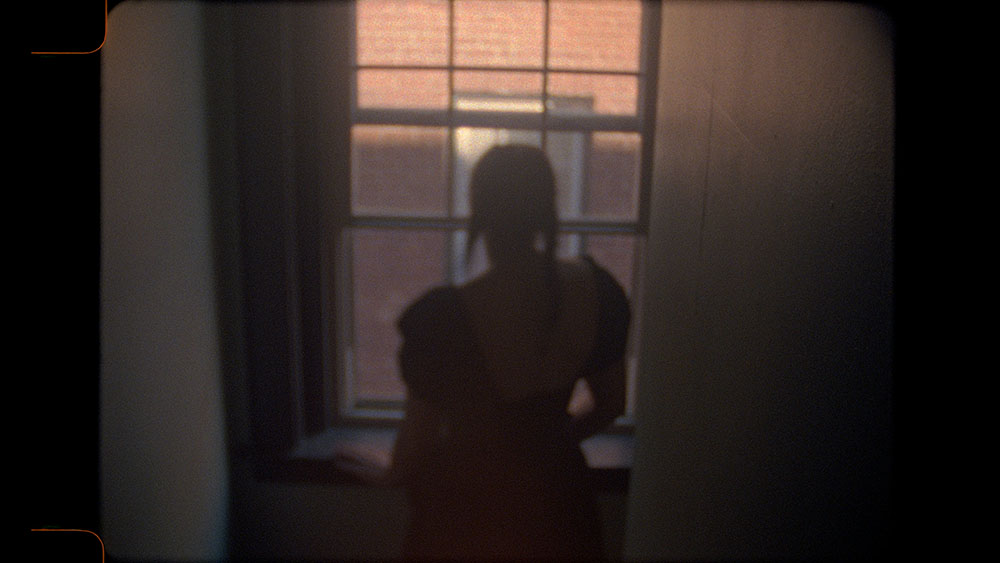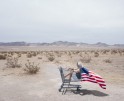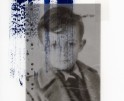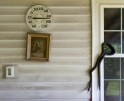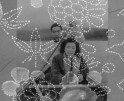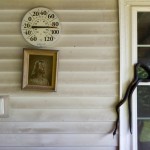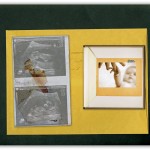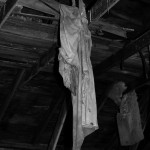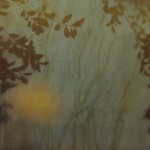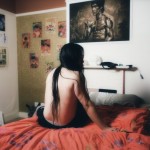Imagination, Creating Space for Black Women and Non-Binary People and Overcoming: Alayna N. Pernell in Conversation with Arielle Gray
Follow Arielle Gray on Instagram: @ariellegray_
There is an overarching presence of matrilineal transference, there are glimpses into the velvety, interior lives of Black women and slivers of what could be considered spiritual awakenings caught in a single frame—baptisms in communion or solitude. An exploration of real and fantastic take place. I am interested in the ancestral ties that bind us and the ritual of dressing up or getting ready. Raised by deeply devout, religious women in the American South, I meditate heavily on the words of Toni Morrison (though, a midwesterner): “of the best of that which is female and the best of that which is male, and that balance is disturbed if it is not nurtured, and if it is not counted on and if it is not reproduced. That is the disability we must be on guard against for the future—the female who reproduces the female who reproduces the female. You know there are a lot of people who talk about the position that men hold as of primary importance, but actually it is if we don’t keep in touch with the ancestor that we are, in fact, lost.” Once self described as a world without men, I am now describing these spaces as a world full of healing, haunting, and self reflection longing for a natural lyricism. My interest in world building and what could be called the Real Imaginary stems from an almost solitary life on a hill in Moundville, Alabama with the four women who raised and support me: my grandmother Bettye, my mother Danyelle, my twin sister Iyana, and a yet to be photographed aunt Gwendolyn (my introduction to queerness). From the home that I grew up in, I have longed to see the interiors of others who look like me and that has been my primary desire for the last two years: longing to create communion through our assorted tapestries of experience and the inevitable connection that accompanies the women who look like me in some shape, form, expression, or mindset—it has bonded us in a universality that is unique to few and far beyond monolithic conventions of Black womanhood. – Arielle Gray
ANP: I’m curious to know more about your artistic journey and the pivotal moment or moments when you knew that you wanted to pursue photography.
AG: I grew up in Moundville, AL which was a very rural part of Alabama. We didn’t live in the suburbs or anything like that. We had this really weird living arrangement where we lived on a hill. It was just me and my twin sister and my mom, essentially as a unit. I think that not having a direct community (like a neighborhood or suburb to reach out to) gave us this opportunity to just kind of imagine and make our own world in a way. My mom has always been super creative and encouraging of us. I think that having that background or that nourishment from my mom really inspired me to continue to do what I love.
When I got to undergrad, I was doing music performance and I changed my major. I got into apparel design and I changed my major. Throughout this whole entire time from maybe, I’ll say elementary school up until high school, I had been using this QVC camera, this Fuji, that my mom had bought for family photos because she would always bring the cameras with her on days when we were super bored. She would make us dress up in matching outfits and just pose around the house and that’s how she took pictures of us growing up. I had gotten so lost in trying to find other things like music and fashion, and I still enjoy those things a lot, but I figured that they weren’t for me at a certain point to pursue professionally. In the midst of changing from apparel design to art, my mom was really supportive and she was just like, You know, you need to like do what you love and I noticed that you’ve always loved photography. It’s okay if you don’t want to be an engineer or be a nurse… I feel like in Alabama those are my options if I wanted to make money, but my mom’s always been a strong supporter of following your passion. The success will follow and you’ll support yourself somehow if you really, truly love what you’re doing. So that’s kind of what brought me to photography.
I think taking classes, like the first couple of introductory classes for darkroom was really exciting to me. I think printing in the darkroom was super exciting, but I always really loved color. So, when I got to the more advanced photo classes with Allison Grant (shout out to her—she’s great), I was really excited because there was this whole world that was presented to me through her. She was showing us a lot of stuff that we had not been introduced to before. I remember when we had intermediate with you, me Candace [von Hoffman].. we had that assignment, and I ended up shooting these studio portraits with this girl I’d gone to music school with. I’d put Vaseline on plexiglass that I got from Home Depot, and shot through the plexiglass with the Vaseline on it. Allison referenced Robert Mapplethorpe and I was like “Who’s that?” So then I pulled all the really big books from the bookshelf that we had in that classroom. I was flabbergasted by the nude ones, of course, because I was super sheltered as a kid; but the texture and the color that he had throughout, like the consistency he had through these nudes…also, in the same way, he showed the same sort of consideration for these bodies that he did like flowers and those still lives were super exciting to me. So, I think that was pivotal.
After that, I was super excited to look and know more photographers and more photo books. I did a whole study of his work throughout a whole weekend of documentaries and books that have been written about his work and finding any and every type of material I could to figure out more of how to work in that way.
I’m sure there’s more moments I can name, but I think that those are the big ones that are coming to me right now for sure.
ANP: That’s really interesting to hear and really heartwarming, too. In the beginning, you were talking about your mom being very supportive of what you wanted to pursue, and I can 100% relate to that as someone whose Mom was also very much like Your dreams will support you to get me to not be so worried about not making enough money.
It’s always really interesting for me to hear how artists get to where they are because I always feel like, to some degree, not all artists start off as artists. They kind of get there through a different way that I think really informs the work they’re making. I feel like yours does too, which I’ll definitely ask questions about too.
I’m curious about your creative process and what your process is like from beginning to end and how that evolved for you.
AG: It’s funny because I have been writing a lot lately in the last couple of years ever since lockdown– just writing thoughts and dreams. I’ve always really enjoyed films and so I guess to speak to more of the pre-planning for things, I find myself going through a lot of archival materials. It doesn’t have to be magazines or other photographers.
I recently found this photo– little pocket wallet size. I don’t even know how to describe it, but it’s a book that says “Salem” on it. It’s actually merchandise from the cigarette company back in the 70s, and it’s just this photo of this guy who’s reclining on a bench, and it’s my first time seeing a cigarette ad from that era with black people in it. The way he’s reclining and the texture on the paper is something that leads me to write little notes about it as an exercise imagining what this person’s like and trying to add specifics to the
photos I’ve been taking.
So, I’ll take a memory from home, like from growing up with my mom and her doing her hair or watching her get ready, watching her get dressed– pulling those memories looking through my closet seeing what I’m attracted to in the closet. It’s really interesting, like the pre-part of everything because it never feels like I’m fully conscious of it until I get the camera in my hands, and I get the person that I’m talking to or friends with because it’s never somebody that I find on Craigslist. It’s just a friend usually that I’m comfortable with and who’s comfortable with me as much as you can be in the situation with the camera.
I had not really used a tripod until recently, even for photos of people. I wasn’t using a tripod, but now while I’m shooting, it’s been really great trying to expand the way that I can compose in frames. Even though I’m still working with majority singular figures in the frame, I’m trying to figure out where I can tease out moments. Before I had these very static figures in the middle of the frame. I’m still trying to figure that out. I want it to be in the camera while I’m shooting and trying not to add too much in post.
When I first started, I went on TikTok and there was this ad from the 80s where it’s makeup and the girl is super glowy and super ethereal looking. I figured out how to do that from TikTok. So, before I applied to Yale, I applied with a couple of photos like that and I showed those photos at crit. I was so intimidated that somebody would call me out for it, but somebody raised their hand and they were like How do you do that effect you have? What do you do? What are you doing? I was like… I don’t think I should say where I got it from, but yeah I’m still working with the ways of production. Overall, it’s the same. Nothing’s really shifted and I still find the people that I feel I have some sort of affinity with. If I tell them the idea they’re like… Okay, I may not get it, but I’m gonna go along with it.
I get a lot of joy out of watching films and seeing if I could make one with an A-frame. That’s kind of the goal sometimes more for the non-family work because I feel like the family work has become a bit more of an organic process for me– just watching the way that my mom and my sister interact with one another, the way that we interact together, and just catching these moments where I’m just like.. Okay, wait. Stop. Let me take a phone photo and then try to do this with my camera next time. I mean you’re never gonna get it exactly the way you got it, even on the phone, but I think working with people who are patient, who support what you’re doing… you can get something better. So that’s been the process.
ANP: I feel like there have been a few segues I could go into in terms of thinking about your process because every artist has a different process. There is some overlap and even with you talking about finding this method of working off of TikTok, I often find myself in places like that too. I’m like Hmm, I kind of like that. I think I want to try it and put my own spin on it.
As we’re having this conversation, I’m realizing this connection that we have as far as our work being primarily centered around Black women and I’m leaning towards that being intentional for you. I know for me it’s intentional, but I guess that could lead to the next question that I have. Are there certain parameters that you have for yourself when it comes to what or who you photograph?
AG: I think first and foremost, no matter who it is, I want them to feel that they can vocalize their concerns with me. My goal is not to make anybody uncomfortable in any way. I think that that should be everybody’s goal. I’m sure it is, hopefully. If it’s not, whatever– but that’s mine. That’s first and foremost from beginning to end. That’s my goal, and then from there I think the way that I’ve began to work more so with women and nonbinary people, it’s a matter of who I want to talk to, not just in sitting but also on the gallery wall or in an installation who I’m trying to speak with and have a conversation with. I feel like there’s so many photographs in the world, but I feel like the ones that I’m making, I’m making them for a very specific reason. I’m aiming for this softness that I feel we’re not given as often as I’d like to see.
I always had this really weird guilty pleasure for Sophia Coppola films. You know, the problematic parts about her films, it’s problematic to us, but it’s also like she’s speaking from her privileged lifestyle which is majority middle/upper-class white people. The work she makes deals around girlhood and all these other things and that’s her line, and that’s her bubble. I think I’ve always been interested in the way that she’s done that. I’m not trying to copy and paste that to black womanhood or girlhood, but I do want to make space for that because I feel like that’s an area of play that we don’t get to have or an area having space for somebody to look and reflect into the image who they see themselves in.
I’m not trying to prescribe anything but that’s one of the interests and the goals that I’ve had at least in the last two years that I’ve become more and more cognizant of as I’ve been making the work. The end goal is to one day be able to make a film, like a coming-of-age film for young black women or nonbinary people. I want that so badly with that same kind of soft aesthetic. You can have that and it could be as weird as we want it to be, you know, and that’s kind of what I’ve always relied heavily on– fantasy and imagination.
I took an African American cinema class last semester and I think that I’ve done a lot of trying to understand and wrap my brain around critical theory-based text in general by watching Eve’s Bayou and wanting more of those in the world. I mean, obviously, different stories and not copy and paste like I said, but the way in which Kasi Lemmons approaches character and building the characters that she does in that film, I want that because I feel like there’s a bridge between fantasy and reality. There’s so many layers to it that we have only scraped the surface of in visual media.
ANP: I think everyone should watch Eve’s Bayou at least one time because it’s an incredible film. We’ve kind of been tiptoeing around– or maybe not even tiptoeing. I think I would just say we’ve been giving context to things that you’re working on. So as the next question, I’m wondering if you can tell me a bit about what you’re working on now, whether it’s one project or multiple projects, and how you knew that this or these were bodies of work or a body of work that you needed to create at this moment.
AG: I’m working on a multitude of things right now. I think if I can categorize them into two big groups, I’ve got my family work, which is this really explosive stack of ideas and thoughts around what I want to do with my family. I think for a lot of people in 20 years, they’re going to have a similar story where it’s like It started in lockdown, you know?
In 2020, I think I was fortunate to have my family with me and to live with them. So, I kind of think about Pictures from Home by Larry Sultan. The way of just having them around all the time and just observing the things that are so normal to me about them are not. Like my mom’s nails are like Flo Jo nails, you know? I’m wanting to not exploit my family but to, in a way, archive build because we don’t have much of an archive. In building upon the archive is getting specific about the things that make us who I feel like we are and that’s one of the big parts of the family project.
Being in Connecticut, I have been able to come back to Alabama and see things a bit differently just based off of the education up here– the texts that people have recommended, all that. I think if I were to categorize this second body of work, it’s like a wrinkly shirt. I’m trying to iron it out, and figure out what exactly it is because it’s not super specific yet. I’ve had so many insecurities around making a body of work because I feel I’m still so new to all this. As I’m getting through with grad school, it’s like I’m learning that a lot of my classmates had bodies of work before they came to grad school, and I’m just like Oh my gosh. So, I’m picking up trying to pick up on the themes and what I’m interested in and what I’ve been interested in.
Going back to what I talked about with womanhood and girlhood and all that stuff, I think within the two projects, black subjectivity is heavy in both of them and with this one, it’s kind of more of an exploration drawing from the family, but building in itself– like a self-reflection and individuality and fantasy. Some of the photos, when I say fantasy, I’m not saying Lord of the Rings fantasy, you know?
I’m speaking to the same apartment building you live in and one day you notice there’s a corner that’s different and it leads to another place where it feels like that strip of life that’s coming in on the wall is somebody looking in from another dimension– something like that. I’m not trying to prescribe work in that way, but building on this individuality, this subjectivity that’s out there in the world like this bridge between what’s real and what’s not. I’m still trying to figure it out, I’m not going to lie.
I’ve been trying to style a little bit more too as far as an extension building on the fantasy of things. Styling has been a big part of it. I can’t tell if that’s because of the interest in fashion that I’ve always had. I recently borrowed dresses from this designer named Batsheva Hay—she’s amazing. The reason I wanted those dresses is because they have that timelessness to it and that’s part of what I want to put into this body of work. I’m aware of the ideas that I want to put into the visual elements as far as dresses and hair and props. With the photo that I made recently with the crown, the clips, and the hair, it was referencing symbols that we’ve seen throughout literature. You know, the crown of thorns or whatever, but only really seeing that symbol placed upon men in society. I’ve been questioning and trying to tease at it a bit and see what that could look like for women– if you really think about all of what black women have to go through. I’m not trying to get into problematic territory here, but you know, I think about every male rapper that’s worn a crown of thorns has always got the biggest ego. Love Kendrick Lamar, not trying to talk about Kendrick, but it’s always in the back of my mind– What about black women?
The mind and the body and the way that we’ve had to share and constantly, give and give and very rarely receive reciprocity from anybody else except ourselves– there’s a space there that I want to make.
ANP: I was actually curious, with fantasy (I’m using this word lightly because it might be other words that may come up with it over time), if that is a space where you’re able to not necessarily solve these issues that you’re thinking of, but kind of work through them.
AG: I’m definitely trying to. I don’t even know if I’m posing questions, you know? Within the work, I’ve had a lot of photos with people’s backs recently. That type of mystery that I’ve been putting into the work is funny because I’m so cognizant of trying to make people comfortable that I’m not even conscious of the fact that I’m making some kind of creepy, weird imagery. Sometimes people are like This is kind of haunting, isn’t it?, and I’m like Why am I doing this?
Maybe instead of fantasy, because I’m not trying to conflate these two terms, it’s a term that I’ve really been wrestling with so maybe not fantasy. Maybe spirituality is another element that comes into the work that has been talked about. I’m trying to navigate my own path on that because I was raised as a Methodist Episcopalian, like African Methodist Episcopal. I’m trying to navigate my relationships there because I’m not trying to question things so much as I’m trying to understand them better.
You know, I think if my grandma saw that I’ve been using a deck of tarot cards every day she’d flip out. I’m trying to connect more (with up here) and how the energy is radiated and things like that. I think I’m putting that in the work– those energies.
ANP: I tried to be really careful with some terminology because, with some of them, I don’t know if I would call it “that”. For me, I don’t see haunting so much as I see mystery in a way that feels inviting enough to where it’s like Okay, this doesn’t feel unsafe. This may also be a result of the intentions that you have with photographing and making sure that things are comfortable. Are these spaces purposely created in your work? Whether it’s through the setting, the clothing, the editing, or lighting that allow you or people who are viewing the work an opportunity to see through these different things that they may be questioning or trying to understand more; or even for you if you’re trying to understand more?
AG: Yeah, I think I’m trying to understand more. Some of the way I spread out the images in a PDF sometimes and I’m like, Okay that’s the back of somebody’s head… That’s the back of somebody’s head. This is that same blocking that’s happening here where I’m cutting off figures with shelves or walls or something like that. I think that’s come up a lot in psychiatry for me, where it’s this blocking of things.
Watching from a distance, a respectful distance is a thing that I’ve considered. I also think, in regards to editing, using warmer lights or softening up textures, it’s like there are these labyrinth-like structures not allowing somebody to see the full face or not allowing somebody to see the full body, but just maybe the foot on the stairs. It’s like trying to supplement that with softening textures, or the light being soft or the light being warm.
I’m at this crossroads with whether or not I want to invite some people in sometimes because I get overly respectful of who’s in the frame. I’m like, God, I don’t want to exploit them in a way but gosh I want people to be able to look in. It’s kind of a weird crossroads that I’m at right now with it.
ANP: Totally understandable. I have a question that I’m kind of blending together. We’re both from Alabama and both went to The University of Alabama (UA). I’m sure that after leaving UA, you’re probably making work that is a little bit different from what you made before and have expanded. So, with that, I’m curious about how your work has shifted and changed from being in Alabama to now being in Connecticut, and if your inspirations have changed.
AG: It’s funny. When I first got here I was super obsessed with getting to know new artists and new photographers that I hadn’t learned about at UA. A lot of the work that I was making at UA was a lot of work for my senior thesis within Icon—the gay bar in Tuscaloosa. A lot of that was something that going into 2020, into the lockdown, I kind of wanted to hold on to those dream-like states that I had in those photos.
Then going to Yale, getting up to Connecticut, it’s been a lot of change. The weather is always overcast here, it’s not as hot. You don’t feel the same warmth up here from people. Again, the weather, the colors of everything, the way people dress here… is so different and it’s been inspiring in a way of expanding past what I was familiar with. I think that the shift I’ve made while being up here, a lot of the work that I was making at UA or even post UA was really tight-in portrait—very 15 millimeters every time. I think in being here, I’ve been encouraged to pull back a bit and consider tableaus.
In the crit space, a lot of the conversation around painting has come up. So, in thinking about Old Western painting as a non-white person dealing with my relationship to Western painting in general, how can I rearrange that for myself? In particular, the image that affirmed that there had been a shift for me wasn’t until the 2nd semester last year, where it’s this blue image of me in this hotel room– which is another thing, I would have never traveled to some weird love motel in New Jersey if I had been in Alabama. First of all, because New Jersey is so far away, but second, because of how it was to go by myself as a woman to this weird honeymoon hotel off the Jersey Turnpike.
I don’t know if you’ve seen the photo, but you look at it and you see there’s a table blocking the door and it wasn’t supposed to be in the photo. It was because my mom was like “You gotta be careful and check your surroundings and make sure you’re protecting yourself”. I think that that’s coming into the work a lot more, especially since not being at home. The idea of protection has come more into the work, not just on a professional level, but on a personal level of being here, that’s shifted.
When I’ve come home to Alabama from breaks, I’ve been able to look at more of the social structures that are in place within my family and within the state and some things seem a little bit more obvious. I think things are clicking a bit more, like in seeking help, mental health check-ins and things with people and the discussions around my family. It’s kind of allowed me to highlight or even maybe make better conclusions as to why things are the way they are in their family. I think that’s been really helpful. Also, about inspiration and has it changed… I think it has.
On a superficial level, I think after the Robert Mapplethorpe obsession, I was just like, Okay, who’s out there making work, like color and all these other things, so I went to Nan Goldin, Nadia Lee Cohen, Larry Sultan– people like that all throughout last year. I was really heavy into Deana Lawson, like obsessed. I was secretly hoping that in a crit somebody would mention her. Of course, it never happened because anytime I even talk around it, they’re like You’re work is nothing like that, and I’m like, Okay! So maybe I’ll end up in that family tree later. I don’t know, but I’m hopeful. Fingers crossed. I’m not going to try too hard, but I am hopeful. Thinking about other artists who are working with family like Diana Markosian and people who are kind of working in this other vein of like— how John Edmonds photographs queer men in Durags and things like that. I’m thinking about black subjectivity in the way of posing in front of a Birth of Venus shower curtain or having the ginger wig with a similar coloring to that painting. It’s shifted and looked like in the way that those people have started to inspire me. Then also in this last year for me, I’ve kind of come back to the people that I was first inspired by.
So I went to this antique market in Connecticut called Mongers Mart and they had this guy who was from Nashville and this little vendor in one of the stations. He had this $15 little Japanese Robert Mapplethorpe photo book. It was showing color work that I’d never seen him make before. It was his advertising work mixed with some of his more personal work. To see those two melted together in this beautiful set of black and white tones that he used in this creaminess that they have… but that being mashed in color with
added vibrance has been kind of nice to see those things come back. It’s felt really full circle.
I’m about to graduate in May, so I’m just excited to even be able to revisit some things with a new set of eyes. I think that’s been really cool for sure. Also, if I can name other people that I’m really interested in– Sara Cwynar. I opened her book Glass Life and when I looked at it the first time, you know that blonde lady with all the math equations in front of her face, and she’s super confused? That’s how I felt about looking at Sara’s book. Then when I met Sara, I was like, Okay let me go look at this again. She talked about Western painting in my crit with her and then I bought the book and I’m looking and I see her referencing all these western painters and the way that she’s tackling it. I’m just like, This is so inspiring. I don’t know if it’s embarrassing myself to say this, but even the Queens of photography, the matriarchs like Lorna Simpson– meeting her and also writing about her work and looking more into somebody that I should have been looking at this whole time.
When LaToya [Ruby Frazier] came to Yale, I was like, Oh my God, because I just picked up that book [The Notion of Family] during the lockdown. I was feeling so lost and like nobody understands the relationship between the environment–like exterior versus interior and how the exterior will inevitably affect the interior and how you cope or how you work with it. That was also really cool I just want to throw that out there.
I’m looking at all my books too right now like I’m sitting right in front of my bookshelf.
ANP: I definitely can relate to that feeling of – Oh, should I be embarrassed? This is someone that I probably should have known a long time ago. I think the more that I learn about people that have been around for a long time, I’m just like, You know what? Maybe this just wasn’t a focus at my school. I didn’t realize the importance of this at first. I also carry grace by saying, I don’t know everybody. I can’t know everybody but at least I’m learning. Which is the main thing… at least I’m learning, right?
AG: Yeah, that’s the important part– the effort with it. That’s why we come here and that’s why we do these things. It’s to learn. You’re right. I think that was another thing about coming up here from Alabama is that shift in perspective, trying to give yourself more grace. I’m not going to lie, I was super intimidated to come up here given the reputation of the program. I was like, Oh my God, my classmates are going to know so much more than I do. Then it’s like, well, we all came here to learn, and so I’m glad that we’re all not the same because if we were all the same, nothing would change. Nothing would move forward. I feel like in constantly growing and learning things, we are moving forward, inevitably. So, thank you for saying that.
ANP: I’m being specific with this question because we are in Black History Month. For the intention of the conversation given that context, if you have advice for any aspiring black artists (I’m using artists broadly) who are either wanting to navigate through this industry to some degree, whether it’s being on the editorial side or being more on the side where I’m at (the educational side)– If you had advice from your vantage point what would you give?
AG: I’ve been thinking a lot about that and I read this article called “Why Intent Matters” by Jay Simple. Overall, he talks about, as black artists (whether you’re in the editorial world or educational or like how I do) this kind of hurdle that I feel we as black artists have had where our white counterparts haven’t. It’s pressure to have to explain things to people before you can even get to talking about what’s on the wall, or what you’re trying to express to people through visual imagery or whatever type of media you’re working in. I think my advice would be to make the work for yourself and the people who you want the work to speak to. I think what I’m trying to say is to not feel pressure to have to explain things to people who usually don’t have to explain things themselves. I think in a lot of my frustrations, particularly within a critical space, is that a lot of white artists don’t have to expand on certain things they say about work. It’s like Oh, I went out into the world to see what it could offer me when I know as black artists we’re going out into the world… and we’re not expecting the world to just give us something when we go out. We go out with a set of ideals that we have to consider
when navigating and people that we have to consider when navigating. I think that that’s a luxury or a privilege that is afforded to white artists. It doesn’t always work to the benefit because at a certain point, we have to move past blind discovery when it wasn’t even something that was truly discovered– when it’s been there the whole time. Does that make any sense?
I think in the essay that I was also reading there was a lot about Manifest Destiny. Like how was it manifested by God? That land was already there like y’all did not discover that. It was already there. I’m not trying to get too hairy with it, but overall I feel you just don’t have to explain anything you don’t want to explain to people. In education, obviously, you’re there to learn, but you shouldn’t feel that pressure to put your trauma out there when other people are just consuming and not reciprocating, you know? They’re not providing any sort of safe space for you.
ANP: Right.
AG: I don’t know if that’s helpful advice, but that’s kind of where my brain’s been at where I feel the pressure to do twice as much just to get to the same spot. It has been on my mind a lot lately. It’s been frustrating to think about, but I feel like nobody can do what we do the way that we do as black artists. I think that there’s always this more specific level of individuality that’s happening when we’re making the work. Not to toot our own horns, but I do feel that.
ANP: That’s true.
AG: I feel like there’s a lot that we have to consider too before— in respect to security, making sure thatwe ourselves are safe before we dispense blindly into a space. It’s like we have to, as black artists,consider access more so than white artists. White people can just kind of show up to a space and havetheir camera and maybe not receive any questions. Also, in the essay, it talks about you’re kind of calling into question How can a white artist go into a predominantly white neighborhood and photograph there?, but black artists can’t quite do that the same way without having those different set of tools of survival going on when they’re walking into those spaces.
ANP: I mean it’s all key. Especially for black artists who are balancing freedom with safety at the same time… which can be hard. I think there are times when it can feel like your only option is to fold in the space that you’re in, but I think it’s important, definitely with all that you’re saying about making sure that you’re not creating work for someone else or to appease someone else. You might feel good in the moment of satisfying someone with your work, but it will never lead to self-satisfaction if it’s not what you want to do.
AG: Yeah, I think that’s the thing too. I want to say about making and creating: I think I can be a very heart eyes and smiley face type personality a lot of the time where I’m like, Just love yourself and the good things will come. It’s so true, though, because if you do what you love at the end of the day, you’re taking the photos that you love—like I can never quite understand when people are like, I’m going to print out this 30 by 40 image on $144 plus paper and tell a room of people that I hate this photograph. I’m like Then why did you print it? You know? Why not print the image that you actually really like instead of wondering and worrying about what everybody else is going to say about it, you know? Do what you love.
I don’t know about working every day in your life because I feel like sometimes you need to have a break and you need to rest. I was going to say this earlier. We talked about abundance and all that, but there’s this Travis Scott–I mean, I know how people feel about Travis Scott; but I used to listen to Rodeo, the album, front to back on the way to school every day in undergrad. There’s always this line from one of the first songs where he’s like “Your ambition will carry you”, and that still sticks with me because my ambition is to be happy and it sounds like Beyoncé.
My ambition is to be happy and to feel joy when I can. I’m not going to lie to myself if I am unhappy. I have to be honest with myself. I have to express that and work from there. I can’t deny that it’s happening, but if I can make an image that I love with the people that I love with the materials that I’m attracted to, you know, then that is what I want to continue to work towards, and work with. It’s a never-ending satisfaction that I’m trying to find for myself and hope that it touches other people.
ANP: It sounds super cynical, but this is reminding me of whenever I’m talking to any of my students. I’m more on the teaching side of pushing students where they’re at and not projecting things that I’ve been taught as a one size fits all. Like, no. If you want to do a collage, for example, okay let’s push that; but I tell them at the beginning of the semester, “If what you’re making, you don’t like, why should I like what you’re making?”
AG: Yeah, exactly. You make something that you don’t like, and you expect a roomful of people to put that into you that they like it. You’re taking a gamble, like a risk on something that’s potentially not worth it for you if you don’t even like it to begin with. So yeah, I agree. I feel like in photo I’ve never seen (until I got here) this interesting play on being super-duper self- confident one day and then super-duper self-deprecating the next. When I feel that, I know I need to take a break because I know I love doing this and I know I would love to teach one day and instill self-confidence in the artists as well. I think that’s necessary, especially with black artists–especially with black women artists.
I’ve been mentoring lately and in particular, there’s always at least one black girl in some of these undergrad photo classes and she’s the only one. She needs support because she’s trying to tap into the things that she’s interested in. She’s thoroughly going at it full force, baring her teeth and ready to sink in, and then there’s a bunch of people who have different opinions. They have different perspectives they kind of gatekeep. They find that unless it’s a deserted Food World parking lot shot on a medium format Pentax on a tripod, that’s not art that you’ve got– like of Black women with rollers in their hair and their long nails, that’s not art to them and I’m just like, No, I’m here to tell you that that is art. That’s your art. That’s what you’re passionate about. It sounds so corny but just don’t let the haters kick you, man. It’s only one photo class and if you don’t like it, there’s somebody out there that’s going to like it.
ANP: Right!
AG: That’s why I always support social media. I don’t know if I can say that “old school” take that it’s ruined photography. I don’t know if I think that because I grew up on Tumblr. So, for me, it was expanding and was letting me know what was out there when I couldn’t go to the library or when I couldn’t have access to a museum or a gallery space. Maybe it’s oversaturated, sure, but I’m just happy that I was able to have access to it. I think access is important too and that some of that access has led to validation. I’m so happy that there’s even a Black Women Photographers database because you don’t get like a lot of those resources before they started. I feel like being black, but also being a woman, you need that support.
I think I said it earlier– we support ourselves a lot of the time. I feel when you’re being an artist that’s so important to have a network of people who can support you in that way because you’re already trying to do half the work of supporting yourself and believing in yourself. Sometimes you have these moments of vulnerability where you need somebody to tell you, “That shit’s fire”. Even if you have lost your confidence in yourself.
ANP: You know, it’s true.
AG: Yeah like those symbols and things that we use are so necessary—like long nails. You see people appropriating that all the time. Where did it come from? Like who is doing that? And it matters, you know? It’s not like it doesn’t matter. In documenting people and working with people, I’m trying to make a time stamp on something that is real, like its attachment to something that was real or existed in a moment. I think you just need that because it didn’t get on TikTok out of nowhere. These things existed whether they were constructed in a photograph or not.
ANP: It’s making me think about all the things I’ve been seeing, especially now with the jokes on Twitter about this whole thing with Mielle products. It’s like Oh, here’s this new discovery of this great hair product, and it’s like… that’s for black hair.
AG: Yeah, it’s like the Mielle Manifest Destiny! I’m sorry like that stuff was on the shelf for years, and then all of a sudden somebody picks it up and discovers it and it’s on your “For You” page and now you have to fight somebody at the Target pickup line. Irrelevant, but I’ve been wanting some of that and of course, they don’t have it. Like, I have to go to the Beauty Supply stores that they don’t put on TikTok…Thank God.
ANP: Oh the day, if it was found out, the difference between Sally’s and a Beauty Supply store. I would lose my mind.
AG: Same, same. I think the Beauty Supply store is a safe space. Come as you are.
ANP: Absolutely. As a final question, this is more of a personal thing so that people can keep up withyou. What’s coming up for you?
AG: For me right now, I guess I can kind of be grateful that I don’t have a lot going on. We’re getting ready for thesis, but the thesis in this program to me is something that I am still wondering how we’re going to tackle it.
With Yale Photo, it takes place in New Haven, New York, and goes to LA—or not even LA. It goes to the West Coast and then potentially to some place, not in this country. So that’s what I’m a part of that I’mworking on now. Fingers crossed; I’m hoping that some type of assignment comes along soon. If anybody’s listening and has ties to photo editors, please let me know because that would be fun, but that’s the immediate future.
I think for myself, and I can share this cause it’s like it’s not something that I’ve actually talked to anybody about yet, but I really want to make a book within the next couple of years. So I’m getting started on writing as a component to it and sharing that. I’ve been making a video that is probably not going to leave the crit space, but it’s about my family, so I’m trying to pull that together and I’m excited about that. I think it’s time to just start working with moving image because I always talked about it and I really want to be about it and make it, so we’ll see.
ANP: Perfect! A lot of exciting things. I’ll plug any and all links in this interview so that people can find where you’re at and what’s going on. Especially for me, I’ve definitely followed people that are in these interviews and stuff.
Also, with the photo editors, because I did an interview [with Lenscratch] last year, and at the bottom, I was like “I need a job!” and I got a job. So, I’m hoping that you get the same response which I’m pretty confident you will even beyond this interview. So, thank you for taking the time to do this interview with me. Allison Grant was the last person that I interviewed for Lenscratch and now I’m interviewing you and we all have that connective tissue. So, it’s like a triangle moment.
AG: Yeah, that’s beautiful. I really appreciate you, too. Thank you so much. It feels so good to reconnect and also be reminded that there’s somebody who’s out there doing the same thing who came from the same place because not a lot of people go. I’m hoping there are more in the future. I feel like there’s no better storyteller than somebody from the South.
ANP: I went through a moment while living in the South where I didn’t enjoy it all. Though after leaving, I realize that there’s just so much richness in the South that I appreciate. It’s a special place. I wouldn’t change my being born and raised there or anything ever.
AG: Yeah, same.
Alayna N. Pernell (b. 1996) is a visual artist, writer, and educator from Heflin, Alabama. Her practice considers the gravity of the mental well-being of Black people in relation to the spaces they inhabit, whether physically or metaphorically. Throughout her research and making, using a compilation of photography, text, and found materials, she unearths and examines the harsh realities and complexities of being a Black American woman.
In May 2019, she graduated from The University of Alabama where she received her Bachelor of Arts in Studio Art with a concentration in Photography and a minor in African American Studies. She received her MFA in Photography from the School of the Art Institute of Chicago in May 2021. Her work has been exhibited in various cities across the United States, including FLXST Contemporary (Chicago, IL), Refraction Gallery (Milwaukee, WI), JKC Gallery (Trenton, NJ), RUSCHWOMAN Gallery (Chicago, IL), Colorado Photographic Arts Center (Denver, CO), Griffin Museum of Photography (Winchester, MA) and more. Pernell was named a 2023 Mary L. Nohl Fellow; in 2020-2021 she was the recipient of the James Weinstein Memorial Award by the School of the Art Institute of Chicago Department of Photography and the 2021 Snider Prize award recipient by the Museum of Contemporary Photography. She was also recognized on the Silver Eye Center of Photography 2022 Silver List, Photolucida’s 2021 Critical Mass Top 50, 2021 Lenscratch Student Prize Honorable Mention, and more.
She is currently the Associate Lecture of Photography and Imaging at the University of Wisconsin-Milwaukee.
Follow Alayna Pernell on Instagram: @alaynapernell
Posts on Lenscratch may not be reproduced without the permission of the Lenscratch staff and the photographer.
Recommended
-
Martin Stranka: All My StrangersDecember 14th, 2025
-
Interview with Maja Daniels: Gertrud, Natural Phenomena, and Alternative TimelinesNovember 16th, 2025
-
MG Vander Elst: SilencesOctober 21st, 2025
-
Photography Educator: Josh BirnbaumOctober 10th, 2025
-
Aiko Wakao Austin: What we inheritOctober 9th, 2025

